Best running shoes 2024, according to our testing
The best men’s and women’s running shoes to buy right now.
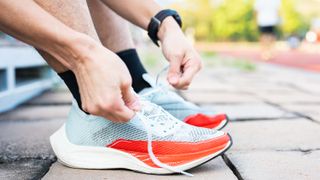
It's hard to keep up with the best running shoes — brands release new models so regularly, it's difficult to know which are actually worth your money. That's why we put the best running shoes to the test, so you can find a pair for your training.
After putting the hours in, we rate the Nike Air Zoom Pegasus 40 as the best for most people because they're just so versatile and comfortable. Or if you're looking for your first pair, you can't go wrong with the Brooks Ghost 15.
But these are far from your only choices. We've rounded up the best running shoes for men and women across a range of budgets, designs, drops, and activities to help you find the most supportive, comfortable shoes for your runs.
The quick list
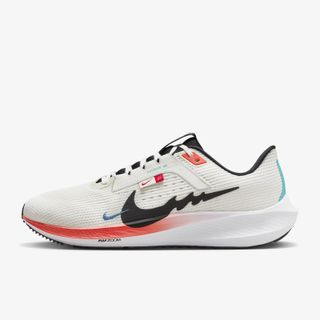
Best overall
The Pegasus is a workhorse — you can wear it for a marathon, your first 5K, and pretty much everything in between. It’s a versatile running shoe, suitable for every level of runner.
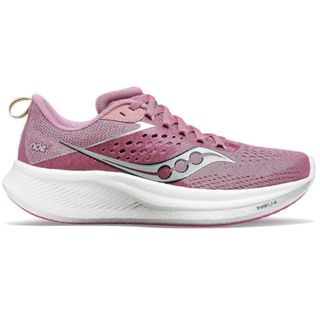
Best daily
The Saucony Ride 17 offers superb versatility, premium features like PWRRUN+ foam, and brilliant value for money, making it an ideal choice for runners seeking comfort, performance, and durability.
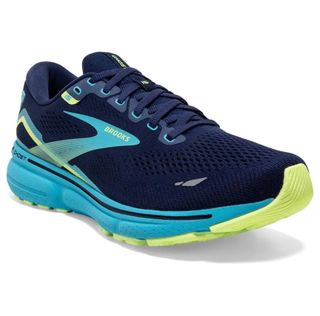
Best for beginners
The Brooks Ghost 15 isn't the most exciting, or the best-looking running shoe, but it's popular with beginners because of its firm, steady midsole, and it's plush upper.
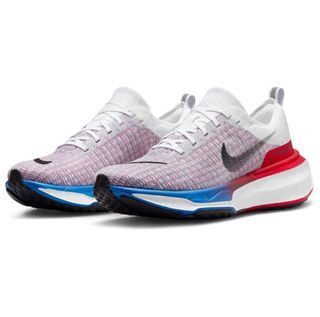
Best max-cushioned shoe
If you love a max-cushioned shoe, it doesn’t get plusher than the Nike Invincible 3. With a thick wedge of ZoomX foam, you’ll feel like you’re bouncing along with this.
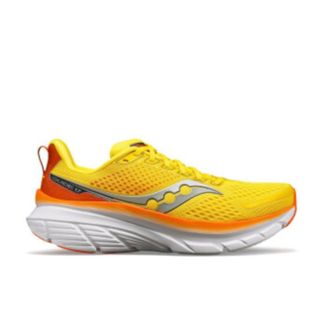
Best for stability
With its broad platform and cradling midsole, the Saucony Guide 17 offers a stable and comfortable ride. This is an excellent shoe for any overpronators or those who prefer a firmer feel.
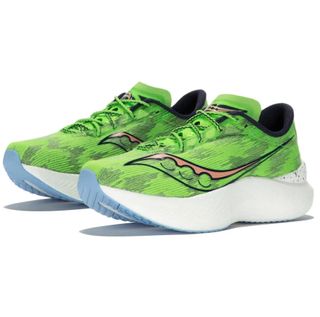
Best for speed
A responsive, stable race-day shoe, that we’d say is the best Saucony has ever made. It’s got an extremely lightweight upper and has a good amount of bounce underfoot.
Click to view more products...
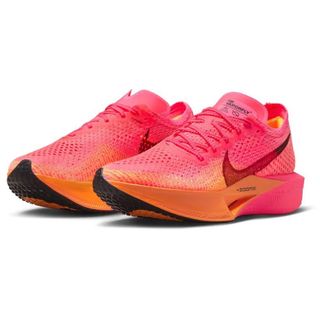
Best for race day
The Nike Vaporfly Next% 3 is an extremely versatile race day shoe, that’ll help you pick up the pace. It’s fast, and more stable underfoot than the Alphafly.
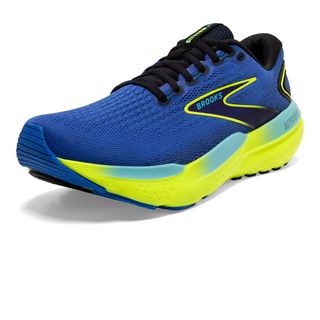
Best value
Known as being Brooks’ ‘softest shoe’, the Glycerin is one of the most popular running shoes around, and the Glycerin 21 is our favorite version of the shoe yet.
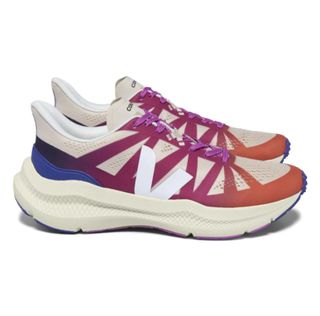
Best eco-friendly
Veja are a brand that pride themselves on making shoes with eco-friendly and sustainable materials and this is the best Veja running shoe we've tested to date thanks to the Condor 3's supreme comfort.
Read more below
How we test the best running shoes
Quite simply, we run in them! While finding the best running shoes for your feet and running style is a personal choice, we've been testing the market's most popular shoes for the past few years, so we know what we're looking for.
When we test shoes, we'll typically run at least 20 miles in them before making our minds up. We're looking at how the shoe performs on different running surfaces, as well as how well it copes with different sessions - some shoes will be great on a long run, but feel heavy during a speed session. We also look at the size and fit of each shoe and anything that makes the shoe particularly impressive, such as carbon fibre plates, or ultra-lightweight midsole foams.
The best running shoes you can buy today
For some categories we couldn't pick just one running shoe for each so make sure to scroll through the full guide to find out which brands and designs made our list and why.
Best running shoe overall
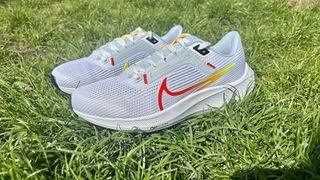
Specifications
Reasons to buy
Reasons to avoid
If you’re a fan of the Swoosh, choosing a pair of the best Nike running shoes can be a tricky choice. While we’re a huge fan of the Nike Air Zoom Tempo Next% for race day, we know not every runner wants to race, which is why the Pegasus 40 sneaked into the top spot here.
It was a close call between this and the Nike Invincible Run 3, which is also a brilliant everyday shoe, but when it comes down to it, the Pegasus was just more versatile during testing. It's got a good amount of React foam in the midsole for a lightweight, snappy feel underfoot, without being overly springy and leaving you feeling unstable on the run. The Pegasus is a workhorse - you can wear it for a marathon, your first 5K, and pretty much everything in between.
For a shoe to be on its 40th iteration, it must be doing something right and with the Pegasus, you're buying reliability. The Nike Pegasus 40 feels pretty similar to the Nike Pegasus 39 underfoot, but Nike has made some tweaks to the fit for a more comfortable underfoot feel. Like the Pegasus 39, the shoe has two Zoom Air units, one under the ball of your foot and one in the heel, for a snappy, responsive feel on the run.
If you're looking for a bargain, now is a good time to buy the Nike Pegasus 39, which is likely to be on sale now the newer shoe has been released.
Bottom line: The Nike Pegasus 40 is perfect for runners who want a reliable, all-rounder that’s ready for anything, whether it’s a Saturday morning parkrun with your mates or marathon training—without breaking the bank.
- Read our full Nike Pegasus 40 review
Best daily running shoe
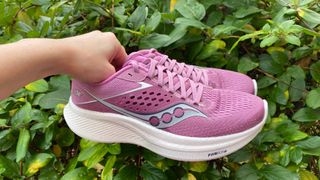
Specifications
Reasons to buy
Reasons to avoid
The Saucony Ride 17 is a dream daily trainer and introduces significant upgrades from the Ride 16, notably the transition to Pwrrun + midsole foam, designed to provide a perfect balance of cushioning and responsiveness. This means each step feels light and bouncy, making your runs feel smooth and effortless.
The revamped engineered mesh upper enhances midfoot lockdown and heel comfort without compromising on flexibility or support. Featuring a stretchy, gusseted tongue and a moderately cushioned yet stiff heel counter, the Ride 17 ensures a snug fit and mile-after-mile comfort.
One minor gripe experienced during testing is the lacing system which loosened during runs. Nevertheless, once adjusted, the shoe excels across diverse running scenarios, from long marathon-training sessions to brisk commutes and speed workouts.
The Ride 17 strikes an impressive balance between cushioning and responsiveness, courtesy of its enhanced midsole foam, offering a soft and bouncy feel. Its smooth midfoot-to-forefoot transition, coupled with a subtle rocker geometry in the forefoot, offers up a nice and efficient forward propulsion.
In our eyes, the Saucony Ride 17 delivers excellent value for money, providing a versatile and high-performing daily trainer with premium features at an affordable price, making it a wise investment for runners of all levels.
Bottom line: The Saucony Ride 17 is ideal for runners who are consistent with their training and want a comfortable, reliable shoe that’s great for racking up miles, whether you're sticking to your weekly routine or gearing up for your first half marathon.
- Read our full Saucony Ride 17 review
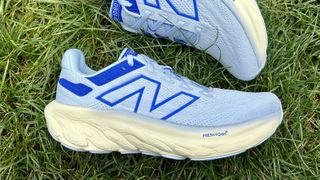
Specifications
Reasons to buy
Reasons to avoid
It goes without saying, you don’t have to own multiple pairs of running shoes to be a runner. While some people might invest in multiple pairs for different sessions, if you’re new to running or are on a budget, you’ll still be able to build fitness and train for races with only one pair in your closet. Plus, if you’re looking for that one pair, the New Balance Fresh Foam X 1080v13 is a brilliant shoe to invest in.
A seriously versatile shoe, the New Balance 1080v13 is soft and plush enough to keep you comfy on your long runs, but can also pick up the pace when you need it for faster tempo sessions. Compared to the New Balance 1080v12, the New Balance 1080v13 has more of the brand's Fresh Foam X midsole foam, and the stack height is larger, yet the shoe has gotten lighter.
The downside here is that the shoe is slightly more expensive than the previous iteration. That said, during testing we were pleasantly surprised by the 1080v13 — it’s a comfortable running shoe, that could easily be worn for anything from a 5K to a marathon. It’s a brilliant example of what you’d expect from an everyday running shoe and a reminder that you don’t need multiple running shoes in your closet to train well for a race.
Bottom line: The New Balance Fresh Foam X 1080v13 is perfect for runners who want one go-to shoe that’s plush enough for long runs, nimble enough for speedwork, and comfortable enough to keep logging miles—no matter the distance or pace.
- Read our full New Balance 1080v13 review
Best running shoe for beginners
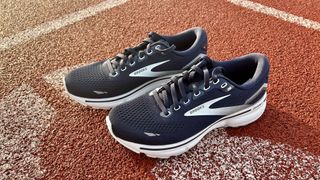
Specifications
Reasons to buy
Reasons to avoid
The Brooks Ghost 15 isn't the most exciting, or the best-looking running shoe on the market, but it's popular with beginners because of its firm, steady midsole, and it's plush upper. Fans of the Brooks Ghost line will not be disappointed with the 15th iteration of the shoe - it feels very similar to past versions and is still a durable, everyday running shoe.
That said, it lacks versatility. While the firmer midsole does the job on slow, easier miles, it’s not overly responsive. It feels pretty clunky at anything that isn’t an easy pace — when trying to do tempo sessions in this shoe it felt a bit ‘meh’, and you had to work hard to get your legs moving in this shoe.
If you're new to running and want a solid shoe that'll support you around your first few miles, this is a reliable choice. If you're a faster runner, or you're looking for a max cushioned shoe, there are better options on the market.
Bottom line: The Brooks Ghost 15 is ideal for beginner runners who want a stable, dependable shoe to build confidence and endurance on easy miles, without worrying about anything too fancy or fast-paced.
- Read our full Brooks Ghost 15 review
Best max-cushioned running shoe
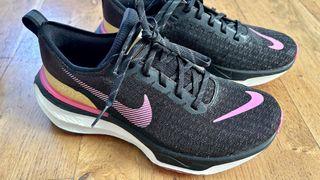
5. Nike Invincible 3
Our expert review:
Specifications
Reasons to buy
Reasons to avoid
Nike has made some changes to it’s maximum cushion running shoe and the Invincible 3 feels a little more grown-up with it’s new upper and heel clip. That said, this is still one of the best max-cushioned running shoes on the market, with a taller foam stack than previous versions to give you more bounce underfoot.
When it comes to the running performance, this shoe is still super plush and super cushioned. Compared to the Nike ZoomX Invincible 2, it has a little more support - the upper is thicker, holding the foot in place, there's a little more support around the arch, and the heel clip is narrower, designed to keep the foot secure.
There's also more ZoomX foam, as the stack height has increased by 1mm. Underfoot, the support is great in the final miles of your long run as your legs tire and your form suffers. That said, if you're a neutral runner and you don't need the support, now is a good time to stock up on the older version of the shoe, which is likely to be on discount.
Bottom line:
The Nike Invincible 3 is perfect for runners who crave an ultra-cushioned, bouncy ride for long distances and recovery runs, with enough support to keep you comfortable and secure through those last tough miles.
- Read our full Nike Invincible 3 review
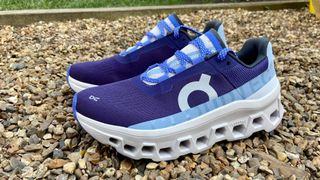
Specifications
Reasons to buy
Reasons to avoid
The Cloudmonster sounds, and looks, a little silly, with its thick wedge of CloudTec. Monster by name and monster by nature, this shoe is huge, but it doesn’t feel it underfoot. Designed for easy runs and long training miles, On has gone for big energy return in its maximalist shoe.
The Cloudmonster is designed to feel cushioned underfoot with On’s latest cushioning material, called Helion. Made from a mix of two different foams (EVA and OBC), which still has a good amount of energy return. The midsole contains On’s CloudTech pods and On’s Speedboard, which is a thin, snappy, thermoplastic layer, designed to help for a faster toe-off. It's definitely more of a long-run shoe than a speed shoe, however.
Fit-wise, the shoe does come up pretty short in the foot, so if you're between sizes, you might want to size up to ensure you don't get any uncomfortable pinching at the toes. We also found during testing that the high stack height led to slight overpronation at the end of long runs, on tired legs, so we wouldn't recommend these for runners who usually wear a support shoe.
All in all, a brilliant easy run shoe for those ploddy miles when you want to get lost in the run.
Bottom line: The On Cloudmonster is great for runners who want a super-cushioned shoe for easy miles and recovery runs, with a soft feel that helps take the strain off your legs on longer days.
- Read our full On Cloudmonster review
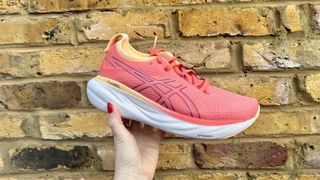
Specifications
Reasons to buy
Reasons to avoid
For a shoe to be on its 25th iteration, it must be doing something right, yet Asics has given its popular neutral running shoe a serious facelift. Asics has called its Gel-Nimbus 25 its "most comfortable running shoe yet" — its added new PureGEL technology and more of its FF Blast Plus Eco cushioning. It's our favorite version on the Nimbus to date and if you're looking for a super plush, super comfortable running shoe for easy miles, this is a strong contender.
During testing, we were impressed. Asics has transformed this neutral running shoe into something exciting. I looked forward to running in it for long and easy miles. The one downside with this shoe is that it’s definitely not a jack of all trades. All that plushness makes it a little on the spongey side when you’re trying to pick up the pace, and faster runners might be put off by this. At $160, it’s also pretty expensive for an everyday running shoe.
That said, if you're looking for a max-cushioned shoe, perfect for easy miles and long runs, this will tick all the right boxes.
Bottom line: The Asics Gel-Nimbus 25 is perfect for runners who prioritize comfort over speed. They offer a plush, cushioned ride that’s ideal for easy miles and long, steady runs.
- Read our full Asics Gel Nimbus 25 review
Best stability running shoe
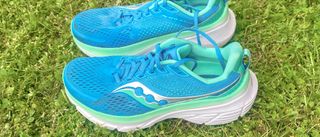
Specifications
Reasons to buy
Reasons to avoid
Engineered with a wide platform and high sidewalls, we found the Guide 17 offered a stable and secure fit that cradled the foot to help stabilize each landing. The design of the shoe is complemented by Saucony's Center Path Technology, which is there to help keep the foot aligned during runs.
The shoe features Saucony’s PWRRUN+ midsole, which we found to provide a good balance of cushioning and support during testing across our long, easy, and recovery runs.
While the cushioning isn't highly responsive, the Guide 17 is a comfortable shoe designed to carry you over a range of distances and has extra features to enhance this such as roomy toe box. The shoe also boasts a breathable upper, which helps keep feet cool and comfortable in a mix of conditions.
Overall, the Saucony Guide 17 is a reliable stability shoe perfect for those needing extra support and cushioning on their easy and long runs.
Bottom line: The Saucony Guide 17 is suited for runners who need a stable, supportive shoe for longer distances. These are an easy go-to solid choice for easy runs and recovery days.
- Read our full Saucony Guide 17 review
Best running shoe for speed
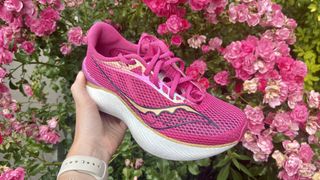
Specifications
Reasons to buy
Reasons to avoid
The Endorphin Pro 3 sees Saucony completely overhaul its most popular carbon fiber road racing shoe. The brand has changed the upper, and added more PWRRUN PB foam underfoot to completely change the ride of the shoe — it’s extremely fast, yet comfortable on the run.
The upper has also been overhauled to more of a mesh — it’s pretty much see-through and during testing I found it to be one of the most breathable uppers on the market. This shoe is fast and comfortable, in a way the Endorphin Pro 2 never really was — it feels bouncy and responsive on the run, yet stable enough to wear for a track session, or a twisty-couse.
We found the shoe does come up a little short in the foot, so it might be worth sizing up half a size. It's also built for race day, so this one won't be as durable as other running shoes on the list, but if you can afford it, it's a great shoe to have on your feet on the start line.
Bottom line: The Saucony Endorphin Pro 3 is perfect for the competitive runner looking for a lightweight, high-performance racing shoe that offers comfort and speed for race day and track sessions.
- Read our full Saucony Endorphin Pro 3 review
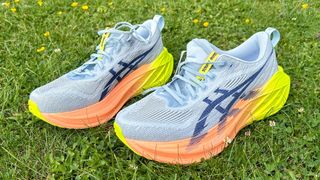
Specifications
Reasons to buy
Reasons to avoid
The Asics Superblast 2 is a stellar choice for runners looking to add a little speed to their training without compromising on comfort. Designed with a high stack of bouncy foam, this shoe provides a cushioned and responsive ride, making it ideal for both long runs and faster training sessions.
Its standout feature is the dual-density midsole, which includes a layer of FF Turbo+ foam—similar to what's used in Asics' high-performance racing shoes. This foam adds an extra spring to each step, helping runners maintain a lively pace over a range of distances. Meanwhile, the bottom section is a layer of which is a foam you’ll find in popular cushioned shoes like the Asics Gel-Kayano 31.
The absence of a carbon plate also means you can enjoy wearing this shoe during easier runs, offering you a pretty versatile speed shoe.
The shoe's AHAR Plus rubber outsole offers reliable traction for running on both wet and dry surfaces, and its breathable mesh upper ensures that your feet stay cool during longer runs.
If you’re someone who likes to save the carbon tech for race day then we think you’ll get good use out of the Asics Superblast 2. We will warn you now though that it’s got quite a hefty price tag on it for a training shoe.
Bottom line: The Asics Superblast 2 is great for runners who want a comfortable, responsive shoe that can handle both speed workouts and long runs without the racing shoe feel.
- Read our full Asics Superblast 2 review
Best running shoe for race day

Specifications
Reasons to buy
Reasons to avoid
It doesn't get better than the Nike Vaporfly Next% 3 on race day. There's a reason why you'll see this shoe a LOT at every major road marathon — they are one of the most popular racing shoes around, and it's easy to see why. The ZoomX foam — the lightest and most responsive midsole Nike makes, plus there’s a full-length carbon fibre plate which helps for a faster toe-off. The shoe feels fast, it’s incredibly lightweight and fits true to size.
The drawback here, of course, is the price — these shoes are definitely an investment and one that might not actually last you for too many miles. While Nike doesn't give an exact figure, as a race day shoe, it's often thought that you won't get all that many miles out of these, so we wouldn't recommend them for your training miles. That said, if you can afford them and you're looking for a PR, you won't be disappointed.
If you're looking for a bargain, now might be a good time to buy the Vaporfly Next% 2, which is likely to be on sale now the newer shoe, with a slightly tweaked design, has been released. Read our Nike Vaporfly Next% 2 vs Nike Vaporfly Next% 3 face-off to help you choose.
Bottom line: The Nike ZoomX Vaporfly Next% 2 is perfect for runners looking to crush personal records on race day. They're designed to give you an extra push for those crucial miles when every second counts.
- Read our full Nike Vaporfly Next% 3 review
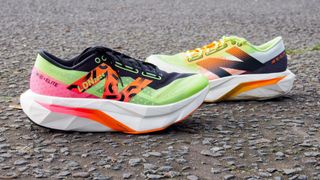
Specifications
Reasons to buy
Reasons to avoid
If you're a runner seeking a comfortable and stable shoe for conquering long distances look no further than the New Balance FuelCell SC Elite v4. We put these shoes to the test during the London Marathon this year and felt the shoe's excellent ability to deliver both plush cushioning and a secure fit. Two features that translates to a confident ride throughout your race, allowing you to focus on maintaining pace and crushing your goals.
The secret to the FuelCell SC Elite v4's success lies in its construction. A carbon fiber plate propels you forward with each stride, maximizing your efficiency. Meanwhile, the responsive foam midsole absorbs impact, keeping your legs fresh over the miles. The upper is crafted from a lightweight, breathable mesh, ensuring your feet stay cool and dry during even the most demanding races.
While some racing shoes prioritize raw speed over comfort, the FuelCell SC Elite v4 strikes a balance. If you're a marathoner seeking a shoe that will get you to the finish line feeling strong and supported, the New Balance FuelCell SC Elite v4 deserves a spot on your shortlist.
Bottom line: Ideal for marathoners who value both comfort and responsiveness, the New Balance FuelCell SC Elite v4 is your go-to choice for long races where you want to feel strong from start to finish.
- Read our full New Balance FuelCell SC Elite v4 review
Best value running shoe
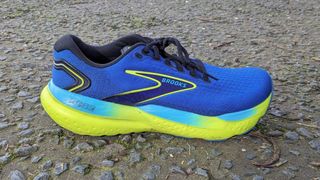
Specifications
Reasons to buy
Reasons to avoid
This upgraded version of Brooks' softest shoe upholds the series' reputation as a comfortable every day pair. They're slightly lighter than the Brooks Glycerin 20, but with the same 10mm drop.
They also retain the previous edition's DNA Loft V3 midsole foam, making them ideal for short runs or long slow-paced sessions. But they're supportive enough for when you need to pick up some speed as well.
There are some modest upgrades elsewhere, with a redesigned upper which is just as comfortable as before, but feels slightly thicker and less breathable. Still, the new padding on the tongue and heel collar felt comfortable during our testing.
Overall, we found that the Glycerin 21 kept the Glycerin 20's focus on durability and comfort, but the lower weight was a welcome change. There may not be enough difference to warrant an upgrade from the 20, but the Glycerin 21 are an excellent, budget-friendly introduction to every day running shoes.
Bottom line: Sometimes durability and plushness win over speed. If you’re seeking a comfortable, cushioned shoe for everyday training, then the Brooks Glycerin 21 is a great choice.
- Read our full Brooks Glycerin 21 review
Best eco-friendly running shoe
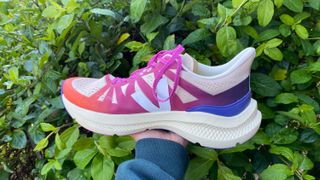
Specifications
Reasons to buy
Reasons to avoid
Finding a high-performing pair of running shoes made from environmentally conscious materials can be a real challenge. Sustainable materials can struggle to match the durability, flexibility, and lightweight properties of common synthetic alternatives. However, the Veja Condor 3 stands out as an exception.
We found the Condor 3 to be exceptionally comfortable for our daily miles, with eco-friendlier materials such as recycled polyester, sugar cane, and Amazonian rubber. The midsole, which combines sugar cane-based EVA and Amazonian rubber, provides a spongy feel and a smooth, cruisey ride. This shoe is perfect for easy, relaxed runs, can handle longer distances too, and has become a favorite walking shoe of mine. That said, it's a bit on the bulkier side, making it less ideal for speed work.
In addition to its performance, the Condor 3 scores high on style—no surprise, coming from a French footwear brand. It's the kind of running shoe that looks just as good off the track as on it, without screaming "I'm a runner!" We've received plenty of compliments on its aesthetic, from runners and non-runners alike.
While it might be a bit pricier than some less versatile trainers, the cost feels justified when considering the sustainable materials and practices behind both the brand and the shoe.
Bottom line: If you prioritize sustainability without sacrificing style or comfort, the Veja Condor 3 should be on your list. Speed isn't the main event with this shoe but you won't be short of a cushy underfoot feel wearing the Condor 3.
- Read our full Veja Condor 3 review
How to choose the best running shoes for you
When it comes to finding the best pair of running shoes for you, there are a few different things to consider. Firstly, how you run. Before investing in a pair of shoes, it's a good idea to head to a running store and have your gait checked. If you overpronate dramatically, you might be better off in a stability shoe to prevent injury.
Secondly, where you plan on running. If you're planning on doing most of your miles on the pavements around your neighbourhood, you'll want a road shoe that's designed to help cope with the impact. If you're hoping to go off exploring in the trails, you'll want a trail shoe with an outsole designed to be grippy on rocky, muddy and wet terrains. If it's a PB you're after, you're likely to want a racing shoe, which will have various features designed to get you a fast finish, for example carbon fibre plates and snappy, reactive midsoles.
Lastly, how often you run. A marathon runner will have different requirements when shopping for running shoes than a runner who clocks the odd 5K. If running isn't really your thing, it's just something you do in the gym now and again, you'll probably want a more affordable shoe.
FAQs
How should running shoes fit?
We spoke to Tony Poland, an expert in sports, rehabilitation, and recovery bodywork who has served on the US Olympic Medical Support Teams in London and Tokyo and on the US Olympic Committee Medical Team in Rio de Janeiro.
"You’re going to want a snug fit everywhere except at the toe. Don’t be afraid of a little extra room around the toes. You want some space in the toe box because too much constriction can lead to injury," Poland explains.
"Your toes should not hit the end of your shoe at rest, and you should always be able to wiggle them around." According to Poland, this is a very foreign concept to most people.
Often people end up wearing shoes that are actually too small. When in doubt, try out a shoe in your usual size, then try one a half size up from that.
How long should a pair of running shoes last?
Speaking to Poland, he tells us that a general rule of thumb is three to four months. However, it's also important to note that everyone’s load is different so this time frame can vary. He says there are a few indicators that can help you assess when to replace your shoes and these include:
- If the tread (the pattern or design on the outsole) is wearing down. Check out the bottoms of your shoes. If they’re smooth with little to no grip left, it’s time to replace them. Tread can be an indicator of the health of the rest of your shoe. If the tread is gone, know that the structure inside the shoe is breaking down a lot as well.
- If the top is fraying or thinning out. Don’t just look at the bottoms of your shoes - it’s possible to wear out the tops of your shoes as well depending on how your toes articulate. Is the woven top of your shoe fraying? It may be time to replace them.
- Check the insole. Is the padding gone? Do they feel flatter? Is the arch support no longer prominent? In general, if the appearance of the insoles is significantly different now than when you bought them, (i.e. cracked or very broken in) it’s likely they’re worn out. While you’re doing this, also check to see which areas are the most worn down. This will help you determine where you place most of your weight when you run, which can help when buying a new pair.
- How are you feeling? If you have pain in your feet or lower back after a run, that’s a pretty good indicator that you need to change your shoes.
What is a zero drop running shoe?
The drop of a running shoe is the difference in height between the heel and forefoot. So, a zero drop shoe means that there's no drop and the shoe (and your foot) sits flat against the ground. These are popular with runners that prefer the feeling of barefoot runs.
What is a neutral running shoe?
For a long time, running shoe brands categorized their shoes are neutral or stability, and which you'd choose would depend on whether your foot rolled over your ankle as you hit the ground (overpronation).
Stability shoes often have a hard medial post alongside the arch of the shoe, while neutral shoes are more flexible and cushioned, suited to those who don't overpronate. However, most brands have developed more versatile support designs now.
But many shoes are still termed neutral, so if you have medium or high arches, you might find these more comfortable for running. And there are plenty of insertable insoles you can buy that address overpronation.
Can you use running shoes for walking?
You can definitely head out on a walk in running shoes, but they're generally better suited to everyday walks rather than hiking or extended time outside. If you need something with more ankle support for uneven terrain, consider a pair of the best hiking boots instead.
Are running shoes waterproof?
The best trail running shoes are designed for wet or slippery conditions and are generally water-resistant and quick-drying. But most running shoes aren't, as the focus is on comfort and breathability.
The upper of the running shoe is designed to hold as little moisture (from water, rain or sweat) as possible so that the shoe stays lightweight and comfortable.
Do men’s and women’s shoes fit differently?
There's a perception that men's and women's running shoes are the same, just in different colors. That's not quite right, though. Women's feet are often narrower and smaller, so the women's edition of a shoe reflects this.
It can be hard to spot these differences visually, as they're usually quite minute changes to the fit, construction, and cushioning. However, some high-end race shoes have a unisex fit, designed to accommodate both.
Sign up to get the BEST of Tom's Guide direct to your inbox.
Here at Tom’s Guide our expert editors are committed to bringing you the best news, reviews and guides to help you stay informed and ahead of the curve!

Jessica is an experienced fitness writer with a passion for running. Her love for keeping fit and fueling her body with healthy and enjoyable food quite naturally led her to write about all things fitness and health-related. If she isn’t out testing the latest fitness products such as the latest running shoe or yoga mat for reviewing then she can be found writing news and features on the best ways to build strength, active aging, female health, and anything in between. Before then she had a small stint writing in local news, has also written for Runners World UK (print and digital), and gained experience with global content marketing agency, Cedar Communications.
Born and raised in Scotland, Jessica is a massive fan of exercising and keeping active outdoors. When at home she can be found running by the sea, swimming in it, or up a mountain. This continued as she studied and trained to become a PPA-accredited magazine journalist in Wales. And since working and living in London, she splits her time between weight training in the gym, trying new fitness classes, and finding scenic running routes. Jessica enjoys documenting this on her fitness-inspired Instagram page @jessrunshere where she loves engaging with like-minded fitness junkies.
She is a big fan of healthy cooking and loves learning more about this area with expert nutritionists she has met over the years. Jessica is a big advocate for building healthy relationships with food rather than building restrictive attitudes towards it. When she isn’t eating or running she also enjoys practicing yoga in her free time as it helps her to unwind and benefits her performance in other sports.
- Jane McGuireFitness editor